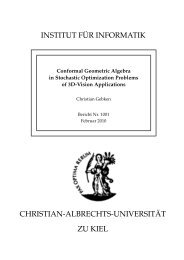Curry: An Integrated Functional Logic Language
Curry: An Integrated Functional Logic Language
Curry: An Integrated Functional Logic Language
Create successful ePaper yourself
Turn your PDF publications into a flip-book with our unique Google optimized e-Paper software.
QFunctionName ::= ( QInfixOpID ) | QFunctionID<br />
QInfixOpID ::= [ModuleID .] InfixOpID<br />
QFunctionID ::= [ModuleID .] FunctionID<br />
QVariableID ::= [ModuleID .] VariableID<br />
Literal ::= Int | Char | String | Float<br />
Int ::= see lexicon<br />
Char ::= see lexicon<br />
String ::= see lexicon<br />
Float ::= see lexicon<br />
If the alternative FunctionDeclaration is used in a ValueDeclaration, then the left-hand side<br />
(FunLHS) must have at least one pattern after the FunctionName (instead of zero patterns which<br />
is possible in top-level function declarations).<br />
In CondExprs, the first expression must have type Success or Bool. In the latter case, Boolean<br />
expressions in conditions are considered as an abbreviation for a (nested) if-then-else (see Section<br />
2.3.2).<br />
If the local definitions in a let expression contain at least one declaration of a free variable,<br />
the expression (after the keyword in) must be of type Success.<br />
In qualified names (e.g., QFunctionID), no characters (e.g., spaces) are allowed between the dot<br />
and the module and entity names. On the other hand, an infix expression (Expr QInfixOpID Expr)<br />
must contain at least one space or similar character after the left expression if the infix operator<br />
starts with a dot.<br />
C.4 Infix Operators<br />
In the grammar above, the use of infix operators in the rule for Expr is ambiguous. These ambiguities<br />
are resolved by assigning an associativity and precedence to each operator (InfixOpID)<br />
by a fixity declaration. There are three kinds of associativities, non-, left- and right-associativity<br />
(infix, infixl, infixr) and ten levels of precedence, 0 to 9, where level 0 binds least tightly<br />
and level 9 binds most tightly. All fixity declarations must appear at the beginning of a module.<br />
<strong>An</strong>y operator without an explicit fixity declaration is assumed to have the declaration infixl 9.<br />
For instance, the expression “1+2*3+4==x && b” is equivalent to “((((1+(2*3))+4)==x) && b)”<br />
w.r.t. the fixity declarations provided in the prelude.<br />
Note that the correct use of precedences and associativities excludes some expressions which<br />
are valid w.r.t. the context-free grammar. In general, the arguments of an infix operator must<br />
have an infix operator at the top with a higher precedence than the current infix operator (or no<br />
infix operator at the top). Additionaly, the left or right argument of a left- or right-associative<br />
operator can have a top infix operator with the same precedence. The unary minus operator is<br />
interpreted with precedence 6 which means that its argument must have a precedence of at least<br />
7. The expression “(- t)” is not considered as a right section but as the negation of t. As a<br />
consequence, the expressions “1
















